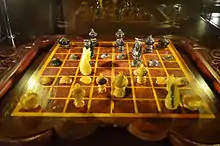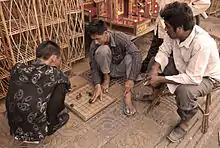Makruk
Makruk (Thai: หมากรุก; RTGS: mak ruk)[1]pronounced [màːk rúk]), or Thai chess, is a board game that is descended from the 6th-century Indian game of chaturanga or a close relative thereof, and is therefore related to chess. It is classified as a chess variant.[2] The word "ruk" (Thai: รุก) in Thai is thought to derive from "rukh" which means "chariot" in the Persian language (and is also the common origin of the name for a rook in western chess). The Persian traders came to the Ayutthaya kingdom around the 14th century to spread their culture and to trade with the Thai kingdom. It is therefore possible that the Siamese Makruk, in its present form, was directly derived from the Persian game of Shatranj via the cultural exchange between the two people in this period. This is because the movement of Makruk Thai's queen, or the "seed" (Thai: เม็ด), is essentially the same as the ferz in Shatranj.
| a | b | c | d | e | f | g | h | ||
| 8 | 8 | ||||||||
| 7 | 7 | ||||||||
| 6 | 6 | ||||||||
| 5 | 5 | ||||||||
| 4 | 4 | ||||||||
| 3 | 3 | ||||||||
| 2 | 2 | ||||||||
| 1 | 1 | ||||||||
| a | b | c | d | e | f | g | h |
Rules
Pieces



- The pawn (called เบี้ย bia, in Thai, meaning a cowrie shell) moves one space forward and captures one space diagonally forward, but unlike in western chess, can't double advance on its first move and, therefore, can't be captured en passant . A pawn that reaches the sixth rank is always promoted (bia-ngai) by flipping it over, so it moves one square diagonally.
| ○ | ● | ○ | ||
| บ | ||||
- The queen[3][4] (called เม็ด met, in Thai, meaning a seed [3]) moves one space diagonally, like the ferz in shatranj . It has the same move as the promoted pawn.
| ● | ● | |||
| ม็ | ||||
| ● | ● | |||
- The bishop (called โคน khon, in Thai, meaning a nobleman) moves one space diagonally or one space forward, like the silver general in shogi.
| ● | ● | ● | ||
| ค | ||||
| ● | ● | |||
- The knight (called ม้า ma in Thai, meaning a horse) moves two spaces in one direction and then one space perpendicular to that movement. It jumps over any pieces in the way.
| ● | ● | |||
| ● | ● | |||
| ม | ||||
| ● | ● | |||
| ● | ● |
- The rook (called เรือ ruea in Thai, meaning a boat) moves like a rook in western chess: any number of spaces orthogonally.
| │ | ||||
| │ | ||||
| ─ | ─ | ร | ─ | ─ |
| │ | ||||
| │ |
- The king (called ขุน khun in Thai, meaning either a feudal lord or a title-holder of the lowest ranks in the ancient Thai nobility) moves like a king in western chess, one space in any direction. The game ends when the king is checkmated. Unlike shatranj, the game ends as a draw if the king is stalemated.
| ● | ● | ● | ||
| ● | ข | ● | ||
| ● | ● | ● | ||
| English | king (1) | queen (1) | bishop (2) | knight (2) | rook (2) | pawn (8) | promoted pawn (queen) |
|---|---|---|---|---|---|---|---|
| Thai | ขุน | เม็ด | โคน | ม้า | เรือ | เบี้ย | เบี้ยหงาย |
| RTGS | khun | met | khon | ma | ruea | bia | bia-ngai |
| Meaning | feudal lord | seed | nobleman | horse | boat | cowrie shell | overturned cowrie shell |
In starting position, pawns are placed on the third and sixth ranks. Queens are placed at the right side of kings. Pawns promote to (เบี้ยหงาย bia ngai, overturned cowrie shells, and move like queens when they reach the sixth rank.
Counting rules

When neither side has any pawns, the game must be completed within a certain number of moves or it is declared a draw. When a piece is captured the count restarts only if it is the last piece of a player in the game.
- When neither player has any pawns left, mate must be achieved in 64 moves. The disadvantaged player counts, and may at any time choose to stop counting. If the disadvantaged player checkmates the advantage side and did not stop counting, the game is declared a draw.
When the last piece (that is not the king) of the disadvantaged player is captured, the count may be started, or restarted from the aforementioned counting, by the weaker player, and the stronger player now has a maximum number of moves based on the pieces left:
- If there are two rooks left: 8 moves
- If there is one rook left: 16 moves
- If there are no rooks left, but there are two bishops: 22 moves
- If there are no rooks or bishops left, but there are two knights: 32 moves
- If there are no rooks left, but there is one bishop: 44 moves
- If there are no rooks or bishops left, but there is one knight: 64 moves
- If there are no rooks, bishops or knights left, but only queens: 64 moves
The disadvantaged player announces the counting of his fleeing moves, starting from the number of pieces left on the board, including both kings. The winning player has to checkmate his opponent's king before the maximum number is announced, otherwise the game is declared a draw. During this process, the count may restart if the counting player would like to stop and start counting again.
For example, if White has two rooks and a knight against a lone black king, he has three moves to checkmate his opponent (the given value of 8 minus the total number of pieces, 5). If Black captures a white rook, the count does not automatically restart, unless Black is willing to do so, at his own disadvantage. However, many players do not understand this and restart the counting while fleeing the king.
Variants
There are rules which do not apply to the standard, formal game, or have been abandoned in professional play. They are called sutras. The first free moves are similar to those in Cambodian Ouk.
- Sut Khun สูตรขุน (King Sutra) can be compared to the castling rule in western chess . The rule allows the player to move the king to a blank square on next row, like a knight, so long as the king hasn't moved yet.
- Sut Met สูตรเม็ด (Queen Sutra) is the most popular sutra in informal rules. It is a first free move that allows the player to move the queen and the pawn in front of the queen at the same time. Two pieces are moved in this sutra. First, move the pawn in front of the queen forward; then move the queen to the blank square the pawn has just vacated, so the queen moves two squares forward.
- Sut Ma สูตรม้า (Knight Sutra) is a first free move that allows the player to move a knight and a pawn a knight's move from that knight in the same turn. Two pieces are moved in this sutra. First, move the pawn which is a knight's move from the knight forward; then move the knight to the blank square the pawn has just vacated.
- Takhaeng Ruea ตะแคงเรือ (Boat Tilting, Rook Tilting) Turn one or both rooks upside down. This changes the rook to be a queen. This reduces the power of one or two rooks.
Cambodian chess

The variety of chess played in Cambodia, called "Ouk" (Khmer: អុក)[5] or "Ouk Chatrang",[6] is virtually identical to makruk, with a couple of minor differences.[7] If no pieces have been captured, the players have these options:
- On the king's first move, and only if not in check, of moving the king like a knight; and
- On the queen's first move, of moving the queen two squares straight ahead.[6]
There is evidence that Ouk has been played in Cambodia since the twelfth century, as it is depicted in several reliefs in the Angkor temples.[7]
Ka Ouk
In the variant "Ka Ouk" (aka "Kar Ouk"), the first player to put the other in check wins.[5]
Tournament
The first Ouk tournament was held in Cambodia 3–4 April 2008, upon the completion of a standardized rule set by the Olympic Committee of Cambodia and the Cambodian Chess Association.[8]
See also
References
- "หมากรุก". thai-language.com. Retrieved 13 November 2018.
- Murray, H. J. R. (1913). A History of Chess (Reissued ed.). Oxford University Press. ISBN 0-19-827403-3.
- How to Play Thai Chess - Makruk - Mak-rook - Makrook - Xiangqi - Shogi
- Makruk: Thai Chess
- Khmer Institute (If the link redirects to the mainpage of the Khmer Institute, click on the "culture" link, then the "chess" link)
- Cambodian Chess games
- Ouk Chatrang, the Cambodian Chess and Makruk, the Thai Chess
- Cambodia to hold first ever Khmer Chess tournament
External links
| Wikimedia Commons has media related to Mak Ruk. |
- "Alisa" The world strongest Makruk program
- How to play Thai Chess
- How to play Thai Chess - by Ancient Chess.com
- Makruk | Chess Variant Pages
- Makruk: Chess in Cambodia
- Ouk chatrang (Cambodian chess) and makruk (Thai chess)
- Free Makruk chess pieces ( svg file format )
- How to Play Makruk (หมากรุก): The Chess of Thailand
